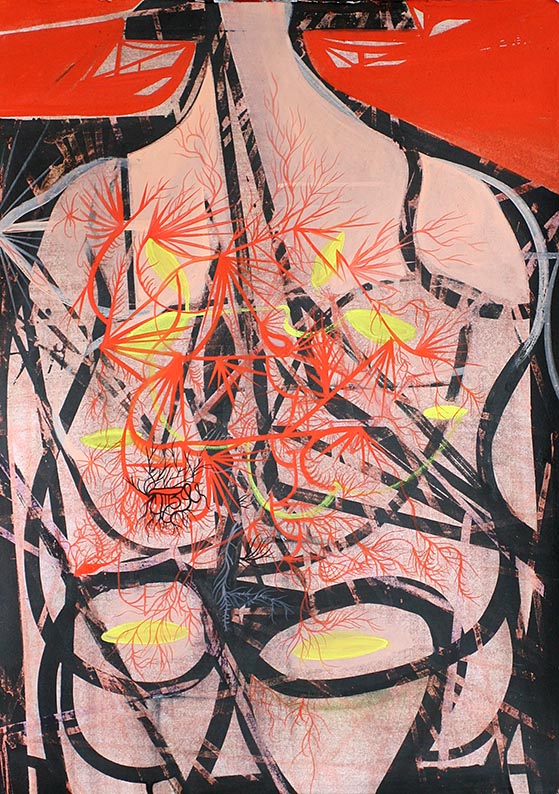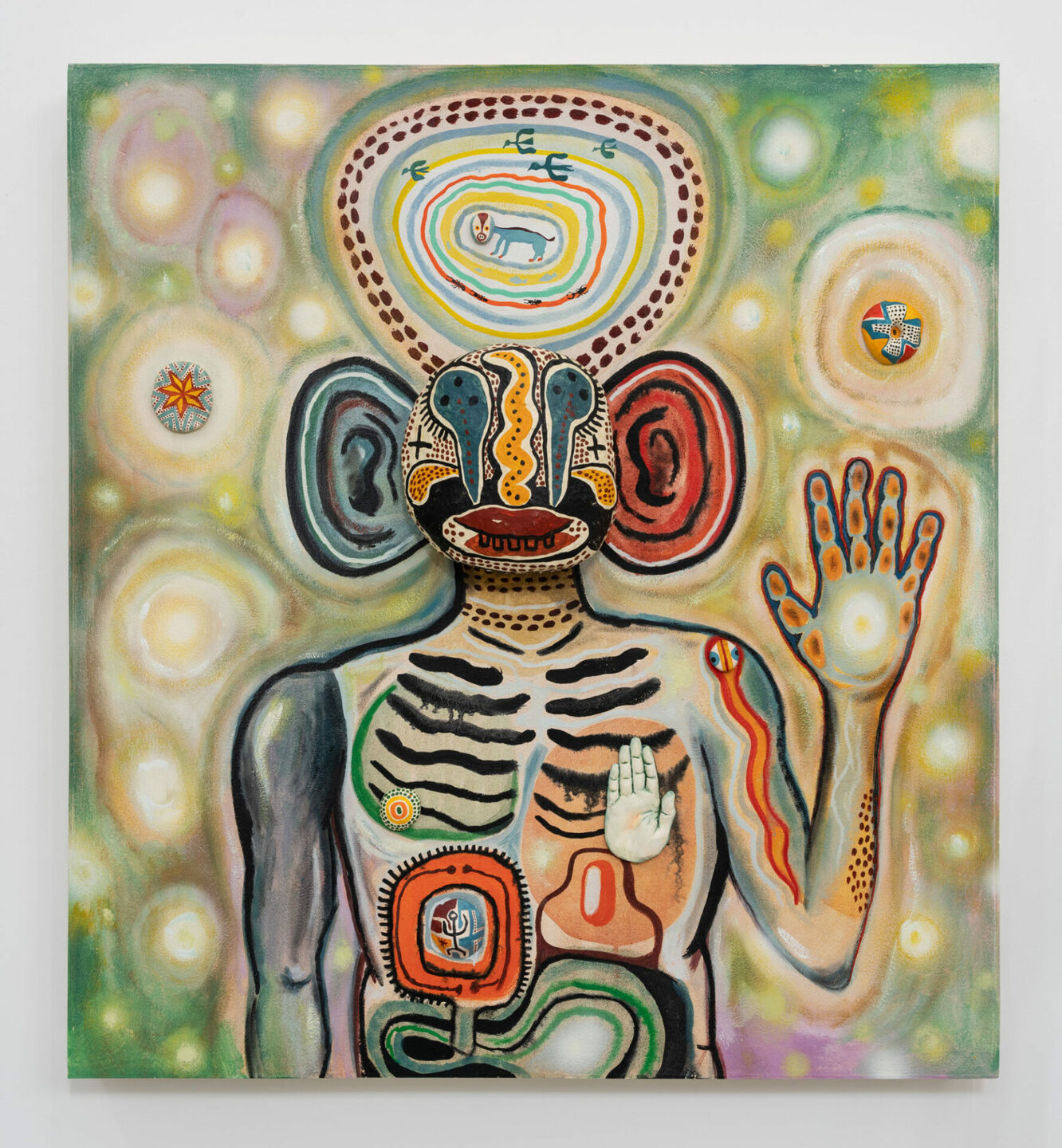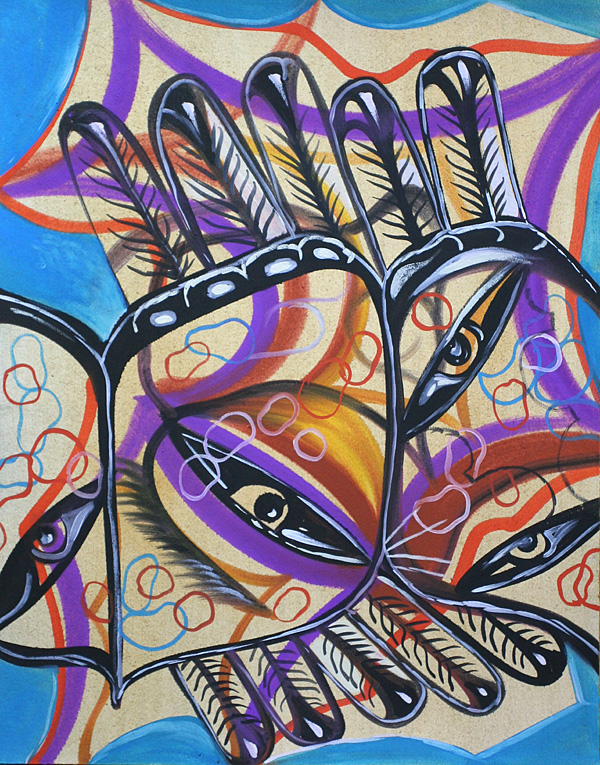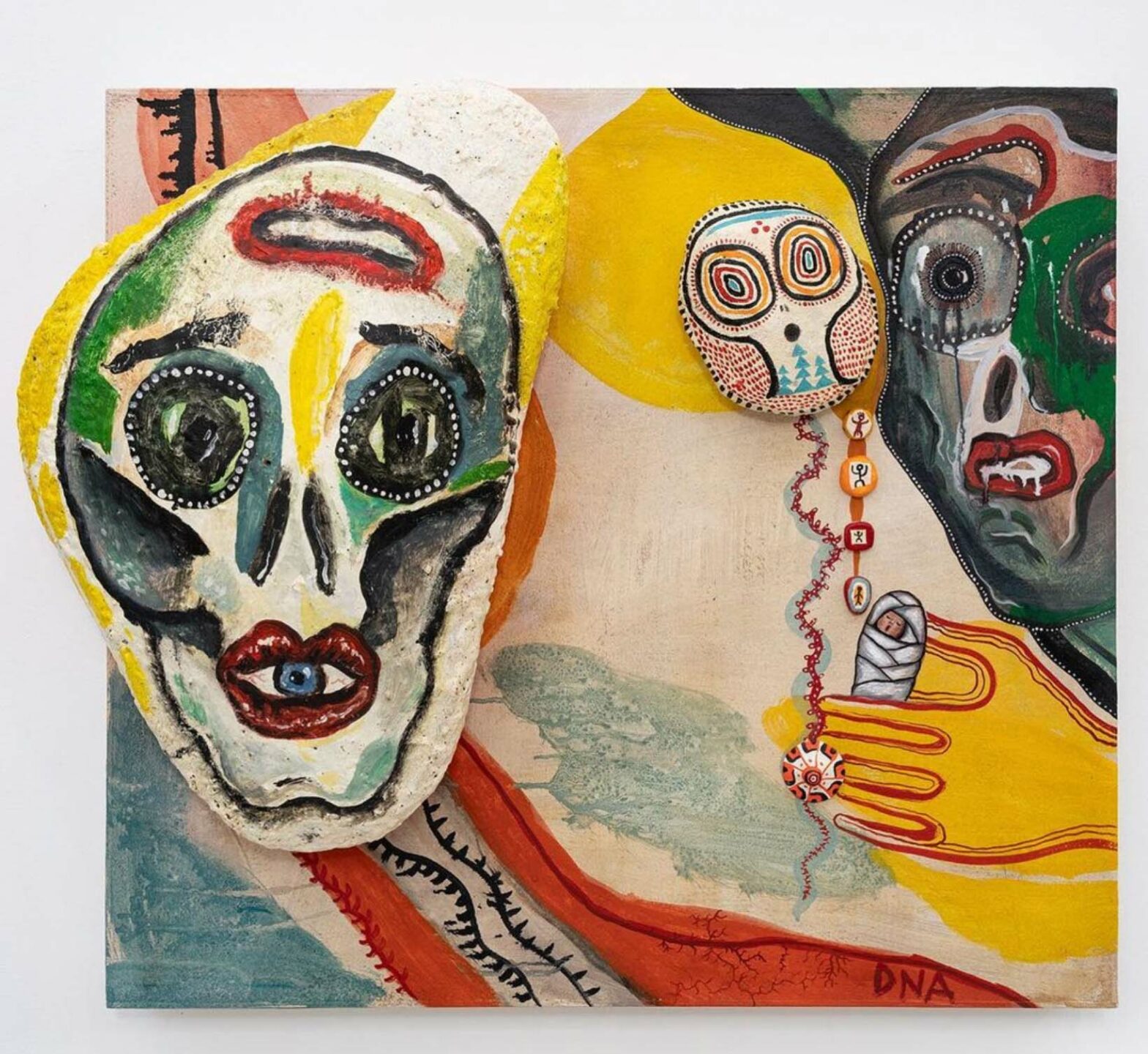Enter Jakub Julian Ziółkowski’s Kaleidoscopic World


Words: Chris Erik Thomas.
Jakub Julian Ziółkowski’s works are bizarre and alluring, like lucid dreams that have found their way onto stretched canvas. The scenes he creates are vibrant and surreal; drenched in references to art history and featuring recurring motifs of everything from snakes and skeletons to potted plants. Each piece he creates invites viewers to gaze deeply into it and untangle the details.
For the Polish artist, art is spiritual. It is an outlet to put on display the results of what he’s found after sifting through his soul. But art is more than just his method of making sense of the world; art is also a vital method of connection. “My thoughts are brushes, paints, pencils. I participate in the rhythm of the world, which is me, passing through me, just as it passes through you,” he explained over email. It is this acknowledgment of the connective tissue of the world that has compelled Ziółkowski’s practice, leading him at one point from Poland to Hanoi in Vietnam as he embarked on what he has called an “internal, spiritual, and creative mission.”
Ziółkowski’s kaleidoscopic works have landed him shows in London, Krakow, Düsseldorf, Warsaw, and many other cities, and secured him representation from the Berlin-based Persons Projects. As we prepare to open the doors to Areal Böhler from April 8-10 for this year’s edition of Art Düsseldorf, we talked to the artist about his dream worlds, his journey in Hanoi, and how growing 50 km away from the Ukrainian border has shaped his view on Russia’s war on Ukraine.

Jakub Julian Ziolkowski. "A Spirit Guide", 2021. Mixed media panel. 90 x 82.5 x 12 cm. © the artist. Courtesy: Persons Projects.
What message do you want viewers to take away from the art you are showing at Art Dusseldorf?
I would rather say that instead of communicating a message, my images have a function. That function is to draw from the depths of the viewer´s voice: look deeper. The direct truth of the vision is wiser than all interpretations.
What inspired the works you have on view at Art Dusseldorf?
When depth comes to the fore – there is a specific state of mind that harmonizes, strengthens, and brings out certain mental functions. The cosmos happens, a tree shoots up, and a person creates a cave painting. Life has a cosmic sense, life is an inspiration.
How has your artistic practice adapted to the pandemic?
A painter is used to working in isolation in a studio that is a shelter from the world, so I don’t think the pandemic situation affected the way I work. I don’t want to disrespect the challenges of lockdown, but I personally liked the peace and quiet, as if every day was Sunday and I could paint so much more peacefully.

Jakub Julian Ziolkowski. "Untitled", 2007. Gouach and ink on paper. 70 x 50 cm. © the artist. Courtesy: Persons Projects.

Jakub Julian Ziolkowski. "Untitled", 2008. Gouach and ink on paper. 45.7 x 35 cm. © the artist. Courtesy: Persons Projects.
How important are art fairs for you as an artist? Has that changed at all because of the pandemic?
I am very happy that my work is being shown at art fairs, but I personally feel overwhelmed by the atmosphere of the fair; the crowds of people running around with their phones, the amount of artworks and galleries. Fairs are much more interesting from a collector and gallery perspective. I’m describing the situation before the pandemic, I don’t know how it is now.
You create dreamlike landscapes in your work. What prompted you to take this world inside of your head, and these images, and turn them into art?
I try to portray as closely as possible the dream that is the world, but my painting is not realistic enough. I worked on myself for years to strengthen that inner voice that brings depth to the surface. My thoughts are brushes, paints, pencils. I participate in the rhythm of the world, which is me, passing through me, just as it passes through you.
How does reality and current events influence your art? Especially, for example, as a Polish artist so close to the crisis happening now in Ukraine.
The brutal attack of Putin’s Russia on Ukraine and the unwillingness of the world to stop this war immediately is a great tragedy and disgrace of mankind.
I come from Zamość, which is 50 km away from the Ukrainian border. Some of my ancestors escaped from what is now Ukraine to Poland, my great-grandfather was murdered in Auschwitz and gave his life to save the life of his son who fought as a partisan against the Nazis. Until now, I lived in the belief that the hell of war could never happen again. What is happening is an unimaginable tragedy and we must do everything in our power to help Ukraine and those fleeing the war.
On 22.02.2022 I stood before a blank canvas that was about the same size as “Guernica”. It is there that the right answer to this question emerges.
We tire ourselves and others with demands and expectations, and we miss the simple joy of living, the joy of creating.

Jakub Julian Ziolkowski. "DNA", 2021. Oil, mixed media, mortar, panel. 61 x 67 x 18 cm. © the artist. Courtesy: Persons Projects.
You have previously stopped painting and left for Hanoi. What lessons did you learn from this period?
I spent a lot of time in solitude; monitoring my thoughts, sitting in colorful temples, watching the harsh and humid sun melt the incense smoke. I was constantly looking for materials and tools that I could use to make something new and experimental, something to refresh my way of thinking about working with materials. It was a kind of an inside journey, an introspection. I made a series of painted ceramic vases, videos, performances, sculptures, reliefs, music, objects, and collaborated with artists and ordinary people from small villages.
I once went to a very small village that is famous for producing votive paper sculpture objects that are used for burning in temples. They cost a few dollars. I decided to personally make a whole series of my own sculptures there, from which I made a big exhibition in Hanoi. I worked on them for weeks, on the ground, in unbearable heat, from morning until dusk. At the end, all my work went up in smoke in 5 minutes. All the villagers gathered, and I captured the smoking scene on video. Such an experience helps to gain distance from what is material, from the transience of all things. In this case, it was about reliving the experience. I burned my paper self-portrait, which I later called Burning Ego. But the longest burning of all the sculptures was the great Dollar Goddess on a burning chariot, she was covered with fake dollars, which the fire was blowing upwards and it looked as if burning money was falling from the sky, before it touched the ground it turned to ashes…
The concept of transience is part of your work, including your past experience burning artworks. How has this concept helped free you as an artist, and what do you think other artists could learn from the idea of impermanence?
We tire ourselves and others with demands and expectations, and we miss the simple joy of living, the joy of creating, the joy of being here and now, the joy of gesture. Drawing is not only about paper and pencil, it is also about the velvety movement of a stick across the water, wandering through the clouds with your eyes. Creativity offers the possibility of synchronization with depth, it is an interaction with the cosmos, a participation in the rhythm of the world. Things appear and pass away, and we with them. Everything is a series of processes, on an infinite scale, that interact with each other. Only humans tend to wave in the opposite direction. Look deeper.
Chris Erik Thomas is the Digital Editor of Art Düsseldorf. They work as a freelance writer and editor in Berlin and focus primarily on culture, art, and media. Their work can also be seen in Highsnobiety, The Face Magazine, and other publications.